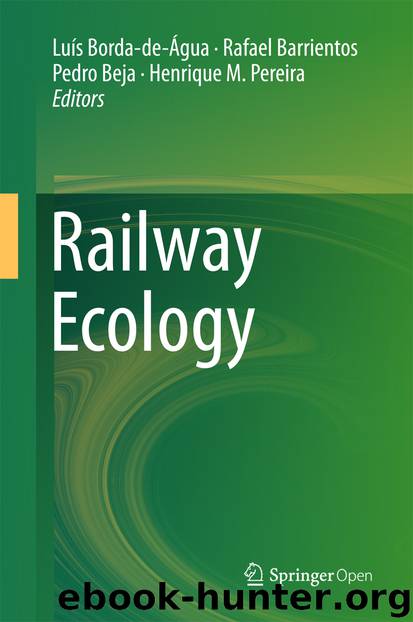Railway Ecology by Luís Borda-de-Água Rafael Barrientos Pedro Beja & Henrique Miguel Pereira

Author:Luís Borda-de-Água, Rafael Barrientos, Pedro Beja & Henrique Miguel Pereira
Language: eng
Format: epub
Publisher: Springer International Publishing, Cham
Keywords
Animal collision mortalityGrain spillageRailroadRelative riskTransportation corridor
Introduction
Like roads, railroads affect wildlife through direct mortality, habitat loss and habitat fragmentation (van der Grift 1999; Forman et al. 2003; Davenport and Davenport 2006). Direct mortalities result when trains strike wildlife. Strikes can be a significant source of mortality for some wildlife populations and have been reported for decades (Child 1983; Gundersen et al. 1998; Bertch and Gibeau 2010a). Studies have reported strike rates for large mammals such as grizzly bears (Ursus arctos) (Bertch and Gibeau 2010a, b) and moose (Alces alces) (Child 1983, 1991; Modafferi 1991).
In Canada’s Rocky Mountain National Parks, train strikes are a leading source of mortality for grizzly bears (0.35 year−1) and black bears (1.95 year−1), and the second largest source of mortality for deer (Odocoileus spp.), elk (Cervus elaphus) and moose (Bertch and Gibeau 2010a, b) in the Banff and Yoho National Parks. It is likely that true mortality rates due to train strikes are higher than reported. For example, as few as 50% of strikes with large mammals were reported by standard observers (train engineers) along the Canadian Pacific Railroad (CPR) during a six-year period (Wells et al. 1999). In other cases, strikes may not be reported except when large groups (>450) of wildlife are killed (Chaney 2011) or when strikes occur within protected areas (Waller and Servheen 2005). Long-term data of train strikes along the CPR exist because strikes have been reported to Parks Canada for at least 30 years. However, other railroads may not report or record strikes with such consistency.
Studies on roads have analyzed the spatial pattern of road-kills, which showed that these occurred in clusters (Finder et al. 1999; Clevenger et al. 2003; Malo et al. 2004). The spatial pattern of road-kills has been explained by landscape, environmental and infrastructure variables (Finder et al. 1999; Hubbard and Danielson 2000; Gunson et al. 2006; Kassar 2005). These studies have helped inform management actions targeted at reducing road-kills (Clevenger et al. 2001; Grilo et al. 2009). At least five general factors are thought to affect the spatial pattern of road-kills and train strikes (Seiler and Helldin 2006). Along railroads, these include: animal (e.g., wildlife abundance and behavior); train (e.g., train speed and frequency); railroad design (e.g., curvature or alignment); and landscape (e.g., vegetation type) variables (Huber et al. 1998; Bashore et al. 1985; Finder et al. 1999; Seiler and Helldin 2006). Driver behavior variables are largely removed from train strike analyses because trains generally cannot stop or swerve to avoid animals.
Landscape variables derived from land cover data have been found to be the best predictors of road-kill rates (Bashore et al. 1985; Finder et al. 1999; Roger and Ramp 2009). We suggest that estimates of relative abundance be used to assess the spatial pattern of road-kills and train strikes. The importance of including wildlife abundance in the analysis of factors contributing to wildlife strikes was demonstrated for moose: strikes coincided with locations of high moose abundance in wintering areas and on migration routes (Gundersen et al. 1998; Ito et al.
Download
This site does not store any files on its server. We only index and link to content provided by other sites. Please contact the content providers to delete copyright contents if any and email us, we'll remove relevant links or contents immediately.
Cecilia; Or, Memoirs of an Heiress — Volume 1 by Fanny Burney(32434)
Cecilia; Or, Memoirs of an Heiress — Volume 2 by Fanny Burney(31868)
Cecilia; Or, Memoirs of an Heiress — Volume 3 by Fanny Burney(31852)
The Great Music City by Andrea Baker(31327)
We're Going to Need More Wine by Gabrielle Union(18967)
All the Missing Girls by Megan Miranda(15561)
Pimp by Iceberg Slim(14378)
Bombshells: Glamour Girls of a Lifetime by Sullivan Steve(13972)
Talking to Strangers by Malcolm Gladwell(13220)
Norse Mythology by Gaiman Neil(13204)
Fifty Shades Freed by E L James(13157)
For the Love of Europe by Rick Steves(12920)
Mindhunter: Inside the FBI's Elite Serial Crime Unit by John E. Douglas & Mark Olshaker(9186)
Crazy Rich Asians by Kevin Kwan(9165)
The Lost Art of Listening by Michael P. Nichols(7403)
Enlightenment Now: The Case for Reason, Science, Humanism, and Progress by Steven Pinker(7228)
The Four Agreements by Don Miguel Ruiz(6619)
Bad Blood by John Carreyrou(6543)
Weapons of Math Destruction by Cathy O'Neil(6139)
